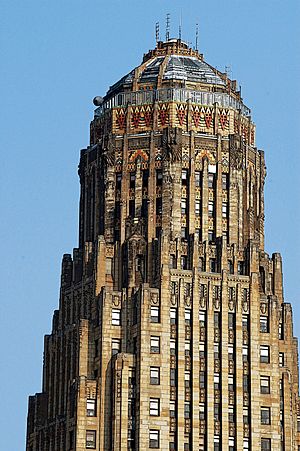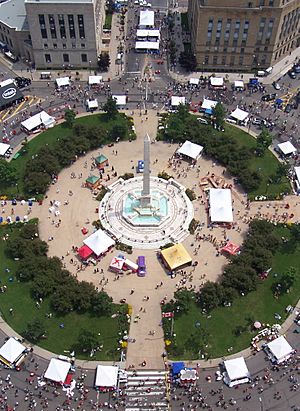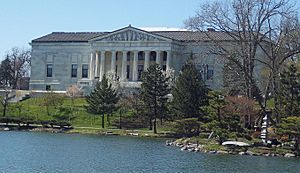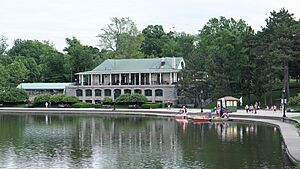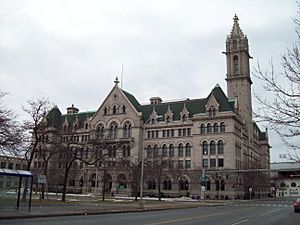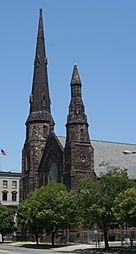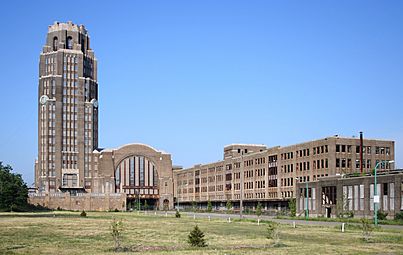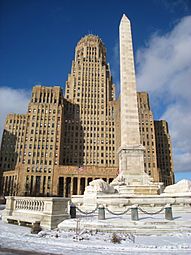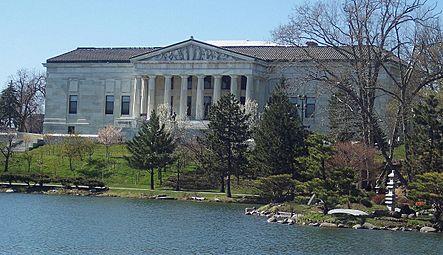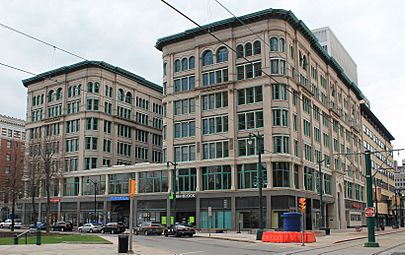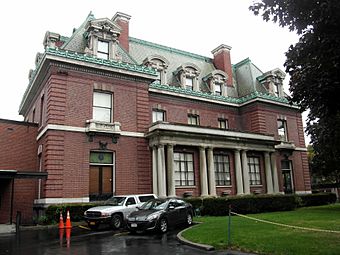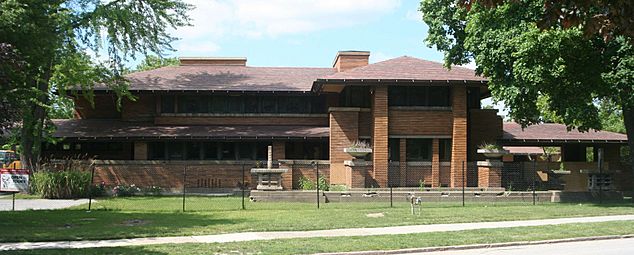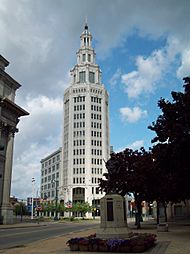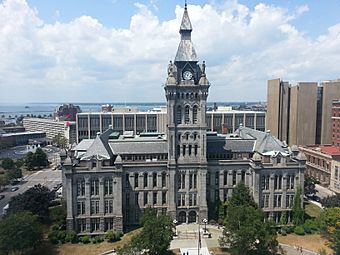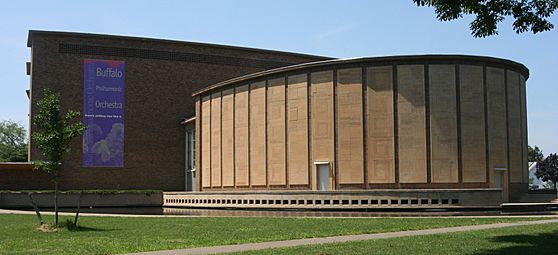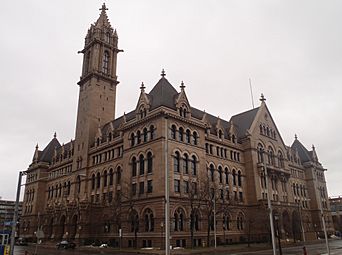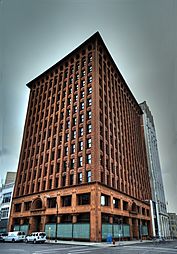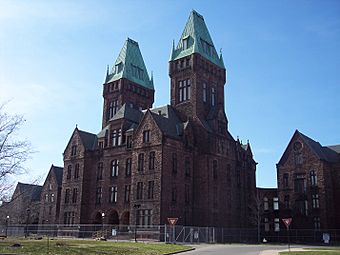Architecture of Buffalo, New York facts for kids
The Architecture of Buffalo, New York is super special! Many buildings built between the American Civil War and the Great Depression helped create a new, truly American style of architecture. This style even influenced designs around the world.
Contents
A Look Back at Buffalo's Buildings
Buffalo's first city plan from the early 1800s was inspired by Paris and Washington. Joseph Ellicott designed the city's streets to spread out like spokes on a wheel. Later, Frederick Law Olmsted added a system of parks and parkways. Buffalo was the first city where Olmsted designed parks that were all connected, not just separate green spaces.
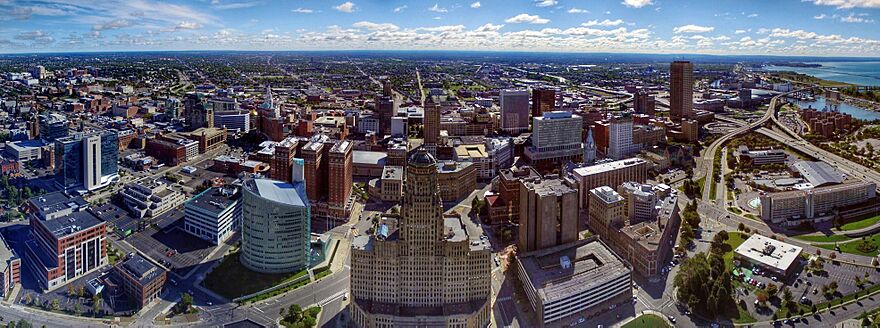
In 1876, famous landscape designer Frederick Law Olmsted called Buffalo "the best planned city" in the United States, maybe even the world!
A writer from The New York Times, Nicolai Ourousoff, said that Buffalo was a place for new ideas in architecture. Architects here were among the first to move away from European styles. They created their own look, based on American ideas about being unique and successful.
Buffalo has buildings designed by amazing American architects like Frank Lloyd Wright, Louis Sullivan, and Henry Hobson Richardson. This makes Buffalo one of the most important cities for architecture in America. You can also find buildings by modern architects such as Minoru Yamasaki and Toshiko Mori.
Buffalo's Tallest Buildings
Here are some of the tallest buildings in Buffalo:
| Rank | Building | Height feet/meters |
Floors | Year |
|---|---|---|---|---|
| 1 | One Seneca Center | 529 / 161 | 40 | 1972 |
| 2 | Buffalo City Hall | 398 / 121 | 32 | 1931 |
| 3 | Rand Building | 391 / 119 | 29 | 1929 |
| 4 | Main Place Tower | 350 / 107 | 26 | 1969 |
| 5 | Liberty Building | 345 / 105 | 23 | 1945 |
| 6 | One M&T Plaza | 317 / 97 | 21 | 1966 |
| 7 | Electric Tower | 294 / 90 | 14 | 1912 |
| 8 | St. Paul's Cathedral | 275 / 84 | N/A | 1851 |
| 9 | 50 Fountain Plaza | 275 / 84 | 17 | 1990 |
| 10 | Buffalo Central Terminal | 271 / 83 | 20 | 1929 |
Famous Architects of Buffalo
Many talented architects and landscape architects have created amazing buildings and park systems in Buffalo. They used many different styles.
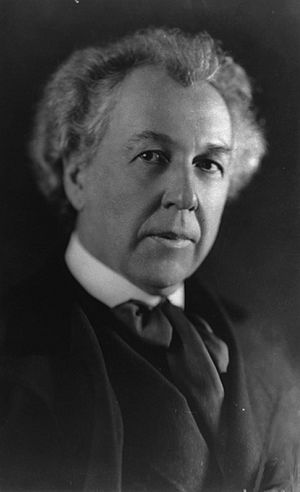
Here are some of them:
- Max Abramovitz
- Dankmar Adler
- Louise Blanchard Bethune
- Marcel Breuer
- Daniel Burnham
- George Cary (architect)
- Robert T. Coles
- Joseph Ellicott
- Edward Brodhead Green
- Wallace Harrison
- Albert Kahn
- Edward Austin Kent
- Kohn Pedersen Fox
- Duane Lyman
- McKim, Mead & White
- Toshiko Mori
- Frederick Law Olmsted
- George B. Post
- Henry Hobson Richardson
- Paul Marvin Rudolph
- Eliel Saarinen
- Eero Saarinen
- Skidmore, Owings & Merrill
- Joseph Lyman Silsbee
- Edward Durell Stone
- Louis Sullivan
- Richard Upjohn
- Calvert Vaux
- Stanford White
- Frank Lloyd Wright
- Minoru Yamasaki
Cool Landmarks and Public Places

Albright–Knox Art Gallery
The Albright–Knox Art Gallery was designed in 1890 by Edward Brodhead Green. A rich Buffalo businessman, John J. Albright, paid for it. It was supposed to be ready for the Pan-American Exposition in 1901, but it wasn't finished until 1905. In 1962, a new part was added, and the museum got its current name. This new part was designed by Gordon Bunshaft. The Albright–Knox Art Gallery is a very important historic building.
Buffalo Central Terminal
The Buffalo Central Terminal is a huge 17-story train station. It was built in 1929 in the Art Deco style by Fellheimer & Wagner. This terminal was made to handle over 200 trains and 10,000 passengers every day! It even had shops, a restaurant, and a parking garage. It's now listed as a historic place.
Buffalo City Court Building
The Buffalo City Court Building is also called Frank A. Sedita City Court. It was designed by Pfohl, Roberts and Biggie and built in 1974. This 10-story courthouse is next to Buffalo City Hall. It's an example of Brutalist architecture, which uses lots of concrete. It has small windows to keep the courtrooms quiet and free from outside distractions.
Buffalo City Hall
Buffalo City Hall is a 32-story Art Deco building finished in 1931. It was designed by Dietel, Wade & Jones. Its walls are made of Ohio sandstone and Minnesota limestone. The building has many cool symbols and decorations that show Buffalo's history. These include images of the Iroquois Indians, the steel industry, and education. Inside the lobby, there are four statues representing good citizenship: Virtue, Diligence, Service, and Fidelity. It's a very important historic building.
Buffalo History Museum
The Buffalo History Museum was built in 1901 for the Pan-American Exposition. It's the only building from that big event that is still standing! It's listed as a historic place and a National Historic Landmark.
Buffalo Main Light
The Buffalo Main Light, also known as The Buffalo Lighthouse, is the oldest building in Buffalo. It was built in 1833 and stopped being used in 1914. You can see it on the city's official seal. It's one of the oldest lighthouses on the Great Lakes! The lighthouse is 44 feet tall and made of thick limestone. It's also listed as a historic place.
Delaware Park System
The Delaware Park System is a historic group of parks in Buffalo. Frederick Law Olmsted and Calvert Vaux designed it between 1868 and 1876. Delaware Park is the biggest park in the system, covering 376 acres. The system also includes other parks and parkways like Gates Circle and Bidwell Parkway. This park system is also listed as a historic place.
Larkin Administration Building
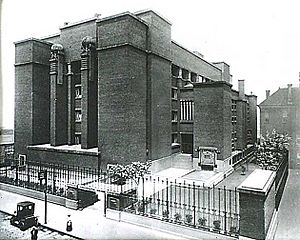
The Larkin Administration Building was Frank Lloyd Wright's first big project in Buffalo. He designed it for the Larkin Company, a mail-order soap business. Wright designed not just the building, but also the furniture, lights, and even the dishes for the cafeteria! He made desks with chairs that could spin to save space. He also added a pipe organ for music, a library, and a greenhouse for employees to relax. This building was important because it was one of the first modern office buildings.
Sadly, the Larkin Company closed in 1937. Even though many people wanted to save it, the building was torn down in 1950.
Old Post Office
The Old Post Office is a historic building at 121 Ellicott Street. It was designed by Jeremiah O'Rourke and opened in 1901. This building cost $1.5 million to build! It was Buffalo's main post office until 1963. From 1901 to 1912, it was the tallest building in the city. It's built in the Gothic Revival style and has a tall 244-foot tower. Since 1981, it has been part of Erie Community College.
Prudential (Guaranty) Building
The Prudential (Guaranty) Building was finished in 1896. It was designed by famous Chicago architects Louis Sullivan and Dankmar Adler. This building is one of the very first skyscrapers ever built with a steel frame! It's decorated with beautiful terra cotta blocks. It's listed as a historic place and a National Historic Landmark.
Richardson Olmsted Complex
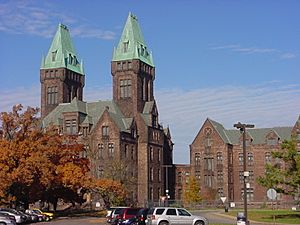
The Richardson Olmsted Complex is a group of hospital buildings made of red sandstone and brick. They were designed in 1870 by architect Henry Hobson Richardson. The grounds were designed by Frederick Law Olmsted. This was Richardson's biggest project, and it started his famous "Richardsonian Romanesque" style. It's listed as a historic place and a National Historic Landmark.
Sculptures and Monuments
Buffalo has many cool sculptures and monuments around the city, including:
- Michelangelo's David
- Soldiers and Sailors Monument (Civil War Monument)
- McKinley Monument
- Wolfgang A. Mozart
- Alexander Petofi (Sandor Petofi)
- John F. Kennedy bust
- Giuseppe Verdi
- Frederic Chopin
- Indian Hunter
- General Daniel Davidson Bidwell
- Commodore Oliver Hazard Perry
Residential Buildings
Birge-Horton House
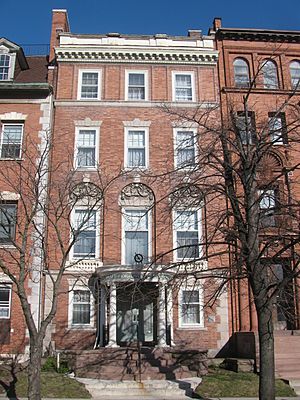
The Birge-Horton House was designed in 1895 by Green and Wicks. It's a Georgian Revival style row house. This four-story brick house is part of the Allentown Historic District. It was the last of thirteen fancy row houses built between 1893 and 1895. Even though different architects designed them, they look like a unified group because they are similar in height and materials.
Charles W. Goodyear House
The Charles W. Goodyear House was designed by Edward Brodhead Green and finished in 1903. It cost $500,000 to build! This home was for Charles W. Goodyear and his wife Ella. It's in the Delaware Avenue Historic District, which is a historic area. The house has brick walls with stone trim and a mansard roof. A large arched doorway marks the main entrance.
Darwin D. Martin House
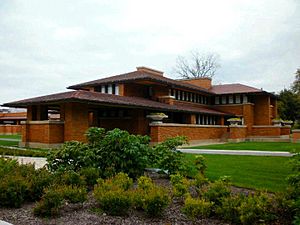
The Darwin D. Martin House was designed by Frank Lloyd Wright and built between 1903 and 1905. It was for Darwin D. Martin, who worked for the Larkin Soap Company. Martin was so impressed with Wright's design for the Larkin Administration Building that he hired him to design his own home. The Martin House is one of Wright's most important Prairie School designs. It's very large and open, with almost 400 unique art glass windows. Some windows have over 750 pieces of colorful glass! It's a historic place and a National Historic Landmark.
Theodore Roosevelt Inaugural National Historic Site
The Theodore Roosevelt Inaugural National Historic Site, also known as the Ansley Wilcox House, was built in 1840. It was first used as officers' quarters for the army. Later, it became a private home. In 1901, President William McKinley was shot while visiting Buffalo. When Vice-President Theodore Roosevelt rushed back, McKinley had already passed away. Because of the sad situation, Roosevelt was sworn in as President right away at the Wilcox home. About 50 important people gathered in the library for the ceremony. The Wilcox family lived in the home until the 1930s. This site is now a National Historic Site.
William Dorsheimer House
The William Dorsheimer House was designed and built in 1868 by Henry Hobson Richardson. It was for William Dorsheimer, a lawyer and important politician. This 2.5-story brick house is on Delaware Avenue. It shows how much French ideas influenced art and architecture after the American Civil War. It's listed as a historic place.
William R. Heath House
The William R. Heath House was designed by Frank Lloyd Wright and built in 1904–1905. It's located at 76 Soldiers Place. It's built in the Prairie School architectural style. William Heath was a lawyer who worked for the Larkin Company. His wife was the sister of Elbert Hubbard, another Larkin executive. The house is on a narrow corner lot, facing a large traffic circle. Wright designed the house to fit this space, with its long side close to the sidewalk.
Gallery
-
Charles W. Goodyear House by Edward Brodhead Green
-
Gates Vascular Institute - Kaleida Health
-
Main Place Tower by Harrison & Abramovitz
Timeline of Important Buildings
Here's a timeline of some notable buildings in Buffalo: Before 1900:
- 1833 Buffalo Main Light
- 1840 Ansley Wilcox House, George Cary
- 1849–1851 St. Paul's Cathedral, Richard Upjohn
- 1868 William Dorsheimer House, Henry Hobson Richardson
- 1870 Richardson Olmsted Complex, Henry Hobson Richardson and Frederick Law Olmsted
- 1871 Delaware Avenue Methodist Episcopal Church, John Selkirk
- 1871 County and City Hall, Andrew Warner
- 1889 St. Louis Roman Catholic Church, Schikel and Ditmar
- 1890–1905 Albright–Knox Art Gallery, Edward Brodhead Green; 1962 addition by Gordon Bunshaft
- 1894 Twentieth Century Club, Green & Wicks
- 1895 Birge-Horton House, Green and Wicks
- 1896 Prudential (Guaranty) Building, Louis Sullivan and Dankmar Adler
- 1896 Ellicott Square Building, Daniel Burnham
- 1896–1898 Williams-Butler House/Jacobs Executive Development Center, Stanford White
- 1897 Old Post Office, Jeremiah O'Rourke
1900–1920:
- 1900 Buffalo and Erie County Botanical Gardens, Lord & Burnham
- 1901 Buffalo Savings Bank, Green & Wicks
- 1901 Buffalo History Museum, George Cary
- 1902–1911 Hotel Lafayette, Bethune, Bethune & Fuchs
- 1903 Charles W. Goodyear House, Edward Brodhead Green
- 1903–1905 Darwin D. Martin House, Frank Lloyd Wright
- 1903–1906 Larkin Administration Building, Frank Lloyd Wright (Torn down, 1950)
- 1904–1905 William R. Heath House, Frank Lloyd Wright
- 1912 City Honors School or Fosdick-Masten Park High School, Esenwein & Johnson
- 1912 Electric Tower, Esenwein & Johnson and E.B. Green and Sons
1920–1939:
- 1923 Hotel Statler or Statler City, George B. Post & Sons
- 1925 Liberty Building, Alfred C. Bossom
- 1926 Shea's Performing Arts Center, Rapp and Rapp
- 1929 Buffalo Central Terminal, Fellheimer & Wagner
- 1929 Buffalo Museum of Science, Esenwein & Johnson
- 1929 Rand Building, F. J. & W. A. Kidd
- 1931 Buffalo City Hall, Dietel, Wade & Jones
- 1938–1940 Kleinhans Music Hall, Eliel Saarinen and Eero Saarinen
1940 to the present:
- 1964–1966 One M&T Plaza, Minoru Yamasaki
- 1969 Main Place Tower, Harrison & Abramovitz
- 1969–1972 One Seneca Tower, Skidmore, Owings & Merrill
- 1974 Buffalo City Court Building, Pfohl, Roberts and Biggie
- 1990 50 Fountain Plaza, Brisbin Brook Beynon Architects
- 2007–2011 Robert H. Jackson United States Courthouse, Kohn Pedersen Fox
- 2009 Eleanor and Wilson Greatbatch Pavilion, Toshiko Mori
- 2012 Gates Vascular Institute, Mehrdad Yazdani of CannonDesign
Architectural Styles in Buffalo

Buffalo's buildings show many different design styles. Here are some of the styles you can find in Buffalo architecture:
- Art Deco
- Art Nouveau
- Brutalism
- Châteauesque
- Federal Style
- Gothic Revival
- Greek Revival
- Italianate
- Second Empire
- Sullivanesque
- Victorian
- Queen Anne


